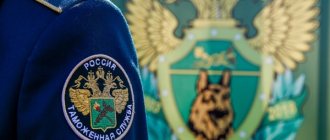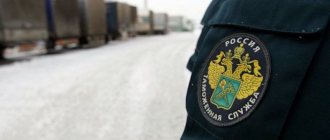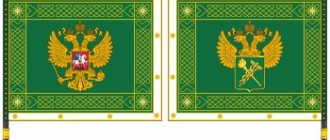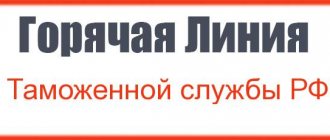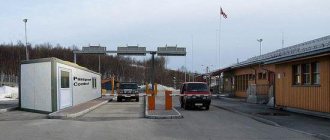DIRECTION FOR DEVELOPMENT OF THE CUSTOMS SERVICE AFTER 2021
№10, 14.12.2017
Economic Sciences
Bonenko Tatyana Andreevna
Makarenko Svetlana Alekseevna
Makrusev Viktor Vladimirovich (Doctor of Physical and Mathematical Sciences, Professor)
Key words: DEVELOPMENT STRATEGY; COMPREHENSIVE DEVELOPMENT PROGRAM; CUSTOMS; CUSTOMS SERVICES; DEVELOPMENT STRATEGY; COMPREHENSIVE DEVELOPMENT PROGRAM; CUSTOMS; CUSTOMS SERVICES.
Abstract: This article discusses a comparative analysis of the Development Strategy of the Customs Service of the Russian Federation until 2021 and the Comprehensive Development Program of the Federal Customs Service of Russia for the period until 2021 and identifying the main directions for the development of customs authorities. The need to modernize the organizational structure and create units that provide information technology equipment and information technology management has been identified and justified.
Introduction.
The transition of the Russian Federation to the innovative principle of economic development, the formation of favorable prospects for the effective integration of the Russian Federation into the world economy, changes in the scale, nature and forms of foreign economic activity form the prerequisites for improving customs activities and developing a strategy for the development of the customs service of the Russian Federation for the long term.
However, the influence of the main world economic factors in conditions of political instability determines the possibility of a deterioration in internal and external market conditions, a decrease in foreign trade turnover, a slowdown in economic growth and the level of investment activity, a decline in industrial production, as well as other negative economic and political phenomena, in turn. requires adjustments to previously made strategic decisions.
Initial provisions.
In 2015, the foreign trade turnover of the Russian Federation decreased by 33% compared to 2014. In 2021, compared to the same period last year, the rate of decline slowed down and amounted to 11%. Moreover, in this period the reduction is primarily due to a decrease in exports (by 17% in 2021).
The value of exports in 2015 compared to 2014 decreased by 31%. In 2021, this decline continued, reaching 43% compared to the “pre-sanction” year of 2014.
The main reason for this reduction was a significant decrease in prices for oil and other commodities, as well as for metals, which are the main export items of the Russian Federation.
It is also worth paying attention to the fact that foreign trade is increasingly subject to political laws to the detriment of the laws of economics. The political factor is increasingly interfering in economic policy, sometimes replacing market competition. Various types of sanctions by foreign states in relation to the Russian Federation and Russian organizations are a clear manifestation of this phenomenon.
The introduction of external sanctions led to a reduction in the value of Russian imports in 2015 compared to 2014 by 36%. Mainly due to a reduction in the import of machinery and equipment. At the same time, at the end of 2021, the decrease in imports stopped, the value of import volumes remained virtually unchanged compared to 2015 (the decrease in imports was 0.4%).
Russia is forced to take retaliatory measures to protect the domestic market of a restrictive nature and customs tariff regulation, which is reflected in changes in the volume of foreign trade and leads to a redistribution of import volumes in the member states of the Eurasian Economic Union (hereinafter referred to as the EAEU), which, in turn, is negative affects the replenishment of the country's federal budget.
Comparative analysis of the Development Strategy of the Customs Service of the Russian Federation until 2021 (hereinafter referred to as the Strategy) and the Comprehensive Development Program of the Federal Customs Service of Russia for the period until 2020 (hereinafter referred to as the Comprehensive Program).
In the presented conditions, the Customs Service Development Strategy is being implemented within the framework of the Comprehensive Program. In this regard, it is advisable to compare two system-forming documents and determine qualitative changes in the process and results of the development of the customs service.
Our analysis shows that the Strategy contains 11 main areas for improving the activities of customs authorities, while the Comprehensive Program offers 18 areas. We numbered the relevant areas and analyzed the documents for consistency. This made it possible to establish the presence of coincidences in the Strategy and the Comprehensive Program, as well as the presence of new areas of development, presented in Figure 1.
Rice.
1. Coinciding areas for improving customs activities. We will consider the remaining areas in more detail. There are 2 areas in the development strategy that were not included in the Comprehensive Program, namely: I. Improving customs regulation; II. Improving organizational and management activities.
Improving customs regulation involves increasing the efficiency of applying measures to modernize customs operations and develop customs technologies, tariff and non-tariff regulation of foreign trade activities, taking into account the active promotion of the national interests of the Russian Federation in the foreign economic sphere, promoting the development of fair competition of business entities by creating more favorable conditions for conducting foreign economic activity for its law-abiding participants, as well as a proactive response to threats to the economic security of the Russian Federation. Table 1 presents target indicators for improving customs regulation.
Table 1
Target indicators for improving customs regulation
| Target/year | 2012 | |
| time limit for passing customs operations when placing goods under the customs export procedure for goods that are not identified as risky supplies requiring additional verification | 72 hours | up to 2 hours |
| time limit for passing customs operations when placing goods under the customs procedure of release for domestic consumption in relation to goods that are not subject to additional types of state control and are not identified as risky supplies requiring additional inspection | 96 hours | 2 hours |
| the share of declarations for goods completed electronically without submitting documents and information on paper, in the total number of completed declarations for goods, provided that the goods (vehicles) are not identified as risky supplies requiring additional verification of documents on paper | 40% | 100% |
| the share of declarations for goods imported into the territory of the Russian Federation, customs operations and customs control in respect of which is carried out by customs authorities located in the border regions of the Russian Federation, in the total volume of declarations for goods | 34% | 65% (by 2020) |
| number of documents required for customs purposes when moving goods across the state border of the Russian Federation during import (export) | 10 pieces | 4 pieces |
| share of cases of non-compliance with restrictions established in accordance with the legislation of the Russian Federation, as well as violations of currency legislation when placing goods under customs procedures | 17% | 11% (by 2020) |
| share of violations of customs legislation and other offenses identified by the customs authorities of the Russian Federation using the risk management system when declaring goods, in the total volume of such violations identified by the customs authorities of the Russian Federation based on the results of customs control | 20% | 95% (by 2020) |
Improving organizational and management activities involves increasing the efficiency of the customs service of the Russian Federation, and this improvement is largely determined by the organization of the management system, which depends on its structure and the activities of all elements.
The need to improve the management system at the present stage is determined by many factors. This includes optimizing the number of management staff, its functions and organizational structure, introducing automated management systems, and developing decision-making systems.
The main tasks in this area are:
- ensuring an optimal combination of centralization and decentralization of management, development of methodological support for the management activities of the management staff of the customs service of the Russian Federation; -development of organizational mechanisms for monitoring and controlling the activities of the customs service of the Russian Federation; -development of a software and technological base that provides information and analytical activities of customs authorities; -strengthening the analytical component at all levels of management and developing the methodological component of the analysis of the activities of customs authorities.
The target indicator of the specified direction of development of the customs service of the Russian Federation is the efficiency coefficient of organizational and managerial activities of the customs service of the Russian Federation (not lower than 90 percent annually).
Thus, the development of target indicators allows you to set a specific goal, which is achieved by certain methods and tools.
The Comprehensive Development Program for Customs Authorities until 2021 has been supplemented with new areas of development, their main characteristics have been revealed, and a unified system of priorities and targets has been established, taking into account economic transformations and foreign policy interests of the Russian Federation.
Innovative areas of development and their main characteristics are presented in Table 2.
table 2
Main directions of the Comprehensive Program for the Development of Customs Authorities until 2021
| Index | Characteristic |
| 1. Improving customs control upon arrival (departure) of goods | Improving the work of customs authorities at checkpoints is inextricably linked with the development of information technology and the institution of preliminary information. |
| 2. Improving customs control when declaring goods | Customs declaration of goods in electronic form made it possible to abandon the submission of a number of documents and gradually automate decisions made by customs authorities, first of all, to introduce technologies for performing customs operations without the direct participation of customs officials - automatic registration of declarations for goods and automatic release of goods. |
| 4. Development of a risk management system | Minimizing fiscal risks, namely understating the customs value of goods, declaring false information about the classification of goods, unfounded declaration of tariff preferences and benefits for customs duties, is a priority activity of customs authorities within the framework of the risk management system. |
| 6. Creation and development of a system of a unified mechanism for administering customs, tax and other payments | A unified mechanism for customs and tax administration, as well as currency control, based on the creation and application of integrated information and telecommunication technologies of federal executive authorities subordinate to the Ministry of Finance of the Russian Federation. |
| 8. Implementation of currency control | New conditions for the functioning of the customs service of the Russian Federation within the framework of global changes determine the need for further development and improvement of currency control carried out by customs authorities. The creation of an effective legal mechanism for currency control is a necessary condition for ensuring state economic interests. |
| 9. Improving the activities of customs authorities in terms of ensuring compliance with prohibitions and restrictions, as well as protecting rights to intellectual property in relation to imported (exported) goods | An integral condition for maintaining favorable conditions for the implementation of foreign economic activity (including for the purpose of supporting exporters of Russian products) is the effective organization of forces and means of customs authorities, ensuring the protection of intellectual property rights, compliance with prohibitions and restrictions, and currency control. |
| 10. Improving the legal support for the activities of customs authorities | One of the main factors in achieving the strategic goal of the customs service of the Russian Federation is compliance with the requirements of the EAEU law and the legislation of the Russian Federation on customs by participants in foreign trade activities, persons carrying out activities in the field of customs, individuals, customs authorities and their officials. |
| 15. Development of interdepartmental cooperation | The main goal of developing interdepartmental interaction is to achieve a level of interdepartmental interaction that allows customs authorities to receive online relevant information necessary and sufficient for making decisions when carrying out customs operations and customs control. |
| 18. Development of expert and forensic activities | The main task of the expert and forensic activities of the Federal Customs Service of Russia is highly professional and complete expert support for customs authorities, both for customs control and law enforcement purposes. |
Conclusions.
In our opinion, the introduction of these measures will allow: 1. To make a transition from the Growth Strategy to a balanced growth strategy. 2. Adequately adjust the directions and results of the activities of the customs authority in the context of ongoing changes.
In general, this will allow us to reach the next level of quality of customs activities, characterized by the following main parameters: - the maximum time for passing customs operations when placing goods under the customs export procedure for goods that are not identified as risky supplies requiring additional verification (from 72 hours in 2012 up to 2 hours by 2018); — the number of documents required for customs purposes when moving goods across the state border of the Russian Federation during import (export) (in 2012 from 10 pieces to 4 pieces in 2021); — the share of cases of non-compliance with restrictions established in accordance with the legislation of the Russian Federation, as well as violations of currency legislation when placing goods under customs procedures (from 17% in 2012 to 11% in 2021).
Research journal
Review of the article
Minina P.S., Tavakalyan A.A., Scientific supervisor: Makrusev V.V., 1,2. 5th year students of FTD Russian Customs Academy G. Lyubertsy, Russia 3. Professor of the Department of Management, Doctor of Physical and Mathematical Sciences, Professor
Minina PS, Tavakalyan AA, Scientific supervisor: Makusev VV 1, 2. 5th year students of Customs department Russian Customs Academy 3. Professor of management department, doctor of physical-mathematical Sciences, Professor
Abstract: The article examines the “Strategy for the development of the customs service of the Russian Federation until 2030” and identifies the main trends in the planned development of customs authorities for the period 2020-2030. The main features of the image of the “customs of the future” are described. The methodological basis of the study is a holistic evolutionary approach, in which the unity of customs authorities reflects changes in their institutional environment in the context of the development of the world economy. Abstract: The article examines the “Development Strategy of the Customs Service of the Russian Federation until 2030” and identifies the main trends in the planned development of customs authorities for the period of 2020-2030. The main features of the image of the “customs of the future” are described. The methodological basis of the study is a holistic evolutionary approach, in which the unity of customs authorities reflects changes in their institutional environment in the context of the development of the world economy.
Keywords: development strategy, customs concept, Federal customs service of Russia, customs authorities
Introduction.
In 2021, the world economy is moving to the fourth level of the technological structure, which is characterized by the development of robotics, biotechnology, nanotechnology and artificial intelligence systems.
This transition can be most clearly seen in the development of the Federal Customs Service of Russia, which is exposed to global changes due to structural changes in the field of foreign trade activities and an increase in foreign trade volumes. Modern trends in the development and regulation of international trade and economics, as well as global technical and technological progress - all this had a direct and immediate impact on the development of the customs authorities of Russia.
It is difficult to imagine what the Federal Customs Service of Russia will look like even after 10-15 years, but today the image of the “customs of the future” in a certain format is presented in the “Strategy for the Development of the Customs Service of the Russian Federation until 2030”. The purpose of our research is to consider the main ideas, conceptual provisions, and determine the most characteristic features of the customs service within the framework of the development strategy.
Objects and methods of research.
In our opinion, the main idea of the development of the customs service until 2030 is the creation of a model of intelligent customs and its further implementation on qualitatively new principles, methods and technological solutions [1]. The methodological basis is a holistic evolutionary approach, in which the unity of customs authorities reflects changes in their institutional environment in the context of the development of the world economy.
Experimental part.
It is worth noting that the development strategy until 2021 provided for the creation of sixteen electronic declaration centers (EDC), automation of the risk management system, automation of the process of registering declarations and issuing declarations. Today, electronic declaration and automation of customs processes is something understandable and obvious, but not sufficient for further functioning. Strategy 2030 is a completely new concept and vision of the customs service in 2030: from electronic customs to intelligent customs.
The implementation of such an idea can be seen especially clearly in the course of a comparative analysis of customs service development strategies until 2020 and until 2030. Main comparative characteristics of the customs image. presented by us in Figure 1.
Rice. 1. Comparative characteristics of the image of customs in the 2020s. and in the 2030s.
The implementation of the idea of intellectualization [2] of customs technical platforms is achievable primarily through the development (adaptation) and implementation of artificial intelligence methods and tools into the customs system, which will allow processing large-scale data and solving mathematical and other problems in order to make decisions based on knowledge.
The innovative directions of the 2030 Development Strategy and their main characteristics are presented in Table 1.
Table 1
Main directions of the “Strategy for the development of the customs service of the Russian Federation until 2030”
| Index | Characteristic |
| 1. Creation of smart customs | The main areas of activity due to the installation of artificial intelligence in the customs authorities system will be: – modernization of checkpoint infrastructure; – introduction of a wide system of traceability of goods on the territory of the Eurasian Economic Union (hereinafter referred to as the EAEU). – one-time presentation of information and application of forms of state control; – elimination of duplication of data in electronic form with paper documents; – increasing the level of automation of risk identification processes at all stages of customs operations; – digital transformation of customs clearance and customs control technologies and processing of large volumes of data using artificial intelligence methods. |
| 2. Technology for assessing product lots online | Depending on the characteristics of the goods, the conditions of its movement across the border and the degree of conscientiousness of the declarant, the system will automatically make decisions on the inspection of a particular shipment. |
| 3. Automation of processes within the risk management system | Its evolution will take place thanks to technologies for determining the risk level of each consignment, the use of artificial intelligence, the exchange of results of the application of RMS with federal executive authorities, the integration of RMS segments of the customs services of the EAEU member states, information interaction with business and the publication of interdepartmental risk profiles. |
| 4. Improving the personnel and organizational structure of customs authorities | Due to the transition to “smart customs”, the requirements for customs officials will be changed: – knowledge and skills in using the latest IT technologies, information systems and resources; – knowledge of methods for analyzing large volumes of data; – ability to quickly adapt and receive additional training. – ability to use systems using artificial intelligence technologies. |
| 5. Avoidance of customs declarations | The entire process of customs regulation will be carried out through control channels of financial documents. Customs will turn into a tool that will fully possess information on the turnover of participants in foreign trade activities and control their activities, becoming part of the process. |
Source: compiled by the author based on the analysis of the “Strategy for the Development of the Customs Service of the Russian Federation until 2030”[3].
Results.
Undoubtedly, the presented provisions, revealing the image of customs in the 2020-2030s, are associated with global processes that influence foreign economic activity and, as a consequence, the activities of customs authorities.
The global digitalization of the world economy is fundamentally changing the essence of goods: a new product – a “digital product” – is increasingly emerging and beginning to dominate. This is a material or intangible object (digital object) or a service provided through information technology (digital service). Based on the findings presented in the monograph, it can be argued that the emergence of a new type of product requires the development of the concept of customs regulation institutions, administration under conditions digitalization of world economic processes [4].
The Institute of Customs Regulation is a system for regulating trade and financial flows using customs instruments and means. This system is formed by political, economic, legal, energy, information and other communications in the EAEU space, and has a fundamental impact both at the global, regional and national levels on the vector of economic development and trade relations.
Figure 2 presents the main paradigms of customs institutions, which reflect the development of customs as a whole.
Rice. 2. Directions for the development of the institution of customs regulation [5]
The modern customs service is presented as a complex of information, technological and technical systems that ensure the regulation of commodity flows across the customs border. Taking into account foreign experience, the most acceptable model for its development is digital or information technology.
A similar need to transform customs authorities into an information technology (electronic, digital) automated customs office, which would function on the basis of information monitoring and controlling, combining analytical functions and risk management functions, is reflected in the Development Strategy-2030.
The main tool for increasing the efficiency of customs administration based on this technology is a risk management system. For its further development, increasing the efficiency and effectiveness of the system for generating risk indicators, new automated technologies are needed. Analytical methods provided by Data Mining technology can cope with this task.
Data Mining is a decision support process based on searching for hidden patterns in data (significant and constantly recurring relationships that determine the stages and forms of the process of formation, development of various phenomena or processes), and is a set of methods for detecting new (formerly unknown, non-trivial) and practically useful data [6].
It is worth noting that the problems of developing the theory and practice of customs regulation in the context of the formation of the digital economy as a whole are complex in nature and cover all levels characteristic of special theories. At the same time, the key problems can be called the creation of intelligent digital customs, the search for adequate models, methods and technologies for the formation and management of knowledge [2].
Conclusion. The Development Strategy 2030 is focused on creating a completely new level of customs service - the creation of an intelligent technological system, which, according to preliminary estimates, will have a qualitative impact on the development of international trade, the growth of trade turnover, achieving high quality customs administration, and creating competitive advantages for law-abiding participants in foreign trade activities.
Customs operations and control will be carried out automatically, with minimal participation of customs officials through the introduction of artificial intelligence and digital systems into customs technologies. At the same time, the customs system will not be “just a machine”; customs officials will exercise direct control, but without actual presence.
Bibliography
1. Order of the Government of the Russian Federation of May 23, 2020 No. 1388-r. Electronic resource. URL: https://customs.gov.ru/storage/document/document_file/2020-06/03/2030.pdf 2. Makrusev V.V., Lyubkina E.O. Problematic issues of intellectualization of the digital customs institute // Economics and entrepreneurship. 2021. No. 2 (115). pp. 932-940. 3. Strategy for the development of the customs service of the Russian Federation until 2030. Electronic resource. URL: https://customs.gov.ru/storage/document/document_file/2020-06/03/2030.pdf 4. Edronova V.N. Digital economy: analysis of statistics of Internet market volumes // Economic analysis: theory and practice. 2021. T. 18. Issue. 9. pp. 1596–1612. 5. Makrusev V.V., Lobas T.V., Lyubkina E.O. Institutional theory of the development of customs regulation in the digital economy // Economic analysis: theory and practice. – 2021. – T. 18, No. 11. – P. 2125 – 2137. 6. V.V. Makrusev et al. / Economic analysis: theory and practice, 2021, vol. 19, no. 3, pp. 416–429
Bibliography
- Order of the Government of the Russian Federation dated December 28, 2012 No. 2575-r “On the Strategy for the Development of the Customs Service of the Russian Federation until 2020” // Reference and legal system “Consultant Plus”.
- Order of the Federal Customs Service of Russia dated June 27, 2017 No. 1065 “On the decision of the board of the Federal Customs Service of Russia dated May 25, 2021” On the Comprehensive Development Program of the Federal Customs Service of Russia for the period until 2021” // Reference and legal system “Consultant Plus”.
- Makrusev V.V., Suglobov A.N., Customs management: Textbook. ITK Dashkov i K, 2021. 348 p.
- Makrusev V.V. Current aspects of the implementation of the concept of service-oriented customs administration // Customs Affairs. 2021. No. 2. 40 p.
- Official website of the Federal Customs Service [Electronic resource]: https://www.customs.ru (access date: 11/15/2017).
